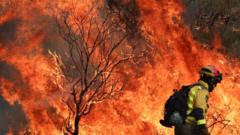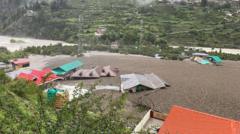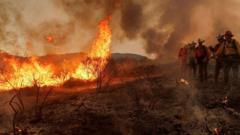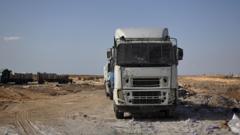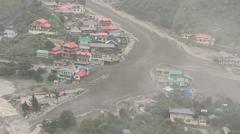The recent heavy monsoon rains have wreaked havoc in Pakistan and Pakistan-administered Kashmir, resulting in over 160 fatalities amidst widespread destruction and ongoing rescue efforts.
Catastrophic Floods Claim Over 160 Lives in Pakistan and Kashmir
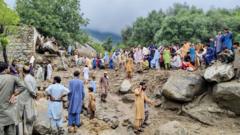
Catastrophic Floods Claim Over 160 Lives in Pakistan and Kashmir
Heavy monsoon rains lead to devastating flash floods and landslides, prompting emergency responses in affected areas.
At least 164 individuals have lost their lives in the past 24 hours due to severe flash floods and landslides in Pakistan and Pakistan-administered Kashmir. The majority of casualties, totaling 150, were reported in the Khyber Pakhtunkhwa province, known for its mountainous terrain. This disaster has led to the destruction of approximately 30 homes, while a rescue helicopter tragically crashed during operations, claiming the lives of its five crew members.
In addition to the casualties in Khyber Pakhtunkhwa, nine fatalities were noted in Pakistan-administered Kashmir, and five individuals lost their lives in the northern Gilgit-Baltistan region. Meteorological authorities have issued warnings of continued heavy rainfall until August 21, with alerts specifically for the northwestern areas of the country. Multiple regions have been officially designated as disaster zones, intensifying the urgency of the response.
Ali Amin Gadapur, the chief minister of Khyber Pakhtunkhwa, confirmed that the M-17 helicopter crash was a direct result of adverse weather conditions while it was en route to the Bajaur district, which borders Afghanistan. Disturbing images emerging from Bajaur depict a crowd gathering around an excavator scooping through a mudslide, while nearby, communal funeral prayers were being held for those lost, with bodies solemnly covered by blankets.
In the Indian-administered section of Kashmir, rescuers are diligently working to recover bodies from debris, with at least 60 fatalities confirmed as floods swept through a Himalayan village. The monsoon season, which spans from June to September, accounts for a significant portion of South Asia's annual rainfall, making landslides and flooding an annual risk, with over 300 deaths reported so far this season.
Notably, Punjab, home to nearly 50% of Pakistan's population, experienced a staggering 73% increase in rainfall compared to the previous year in July, leading to higher mortality rates than previously recorded throughout the entirety of the monsoon season. Scientists have linked the rise in both the frequency and intensity of such weather events to the impacts of climate change, underscoring the urgent need for adaptation and resilience strategies in vulnerable regions like Pakistan.
In addition to the casualties in Khyber Pakhtunkhwa, nine fatalities were noted in Pakistan-administered Kashmir, and five individuals lost their lives in the northern Gilgit-Baltistan region. Meteorological authorities have issued warnings of continued heavy rainfall until August 21, with alerts specifically for the northwestern areas of the country. Multiple regions have been officially designated as disaster zones, intensifying the urgency of the response.
Ali Amin Gadapur, the chief minister of Khyber Pakhtunkhwa, confirmed that the M-17 helicopter crash was a direct result of adverse weather conditions while it was en route to the Bajaur district, which borders Afghanistan. Disturbing images emerging from Bajaur depict a crowd gathering around an excavator scooping through a mudslide, while nearby, communal funeral prayers were being held for those lost, with bodies solemnly covered by blankets.
In the Indian-administered section of Kashmir, rescuers are diligently working to recover bodies from debris, with at least 60 fatalities confirmed as floods swept through a Himalayan village. The monsoon season, which spans from June to September, accounts for a significant portion of South Asia's annual rainfall, making landslides and flooding an annual risk, with over 300 deaths reported so far this season.
Notably, Punjab, home to nearly 50% of Pakistan's population, experienced a staggering 73% increase in rainfall compared to the previous year in July, leading to higher mortality rates than previously recorded throughout the entirety of the monsoon season. Scientists have linked the rise in both the frequency and intensity of such weather events to the impacts of climate change, underscoring the urgent need for adaptation and resilience strategies in vulnerable regions like Pakistan.


